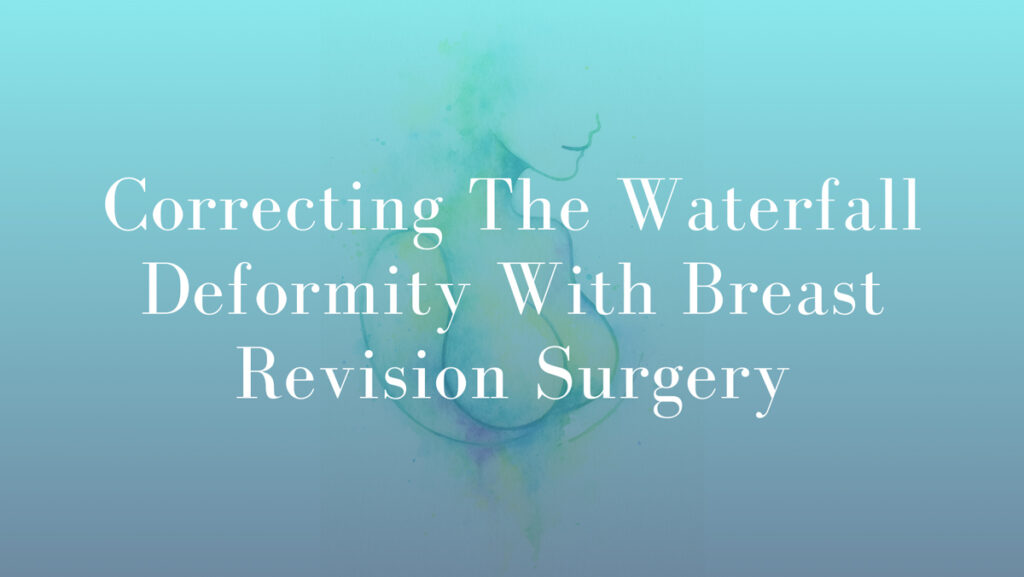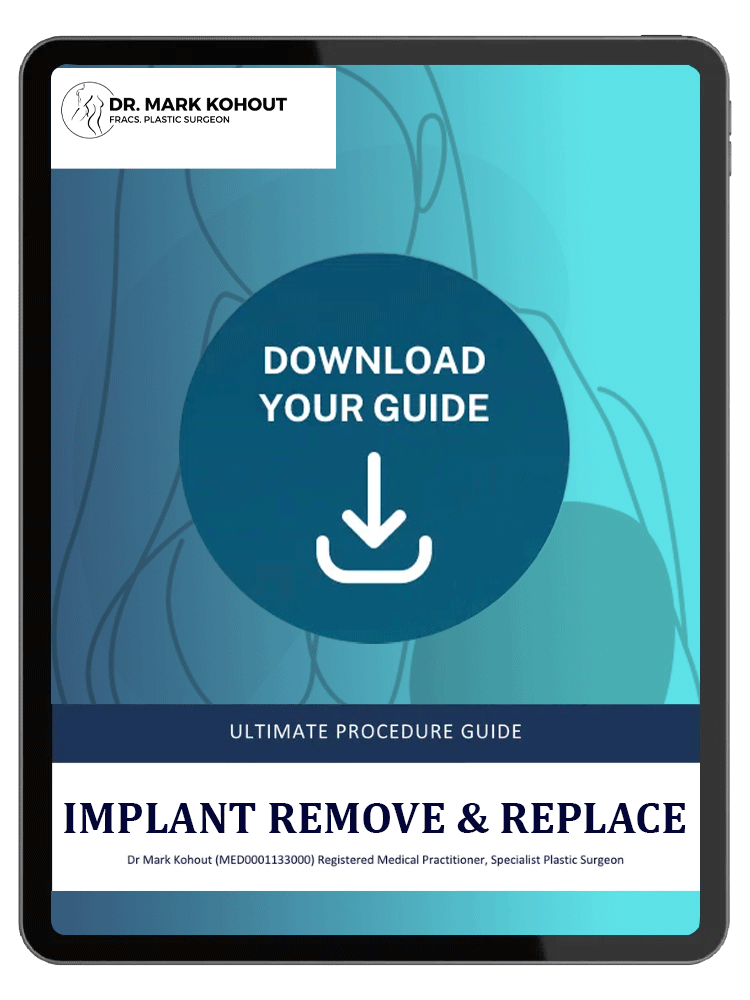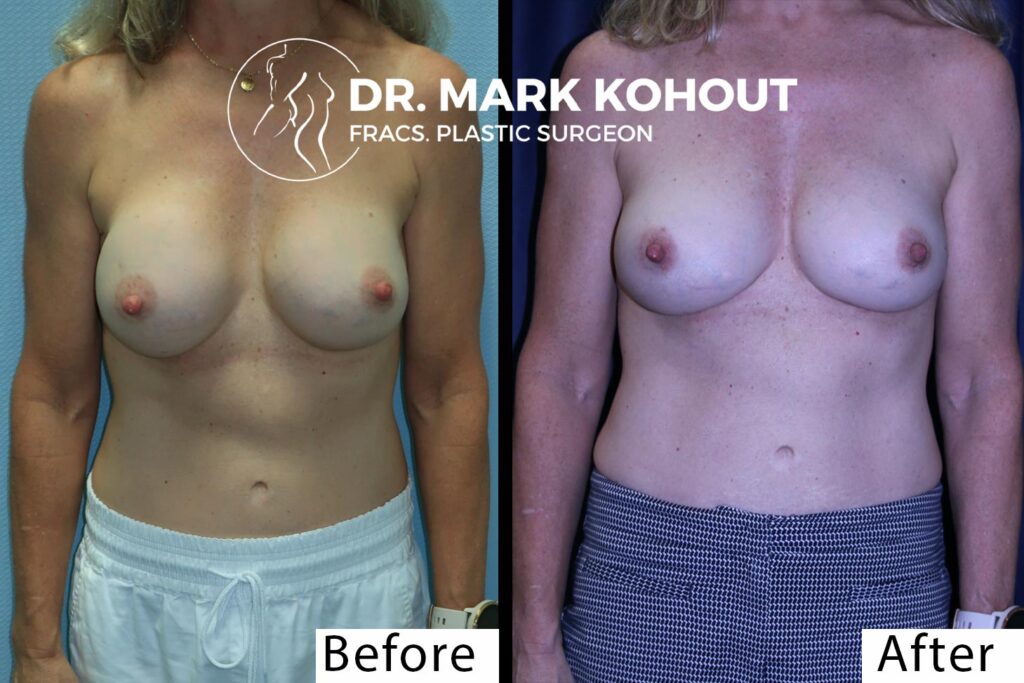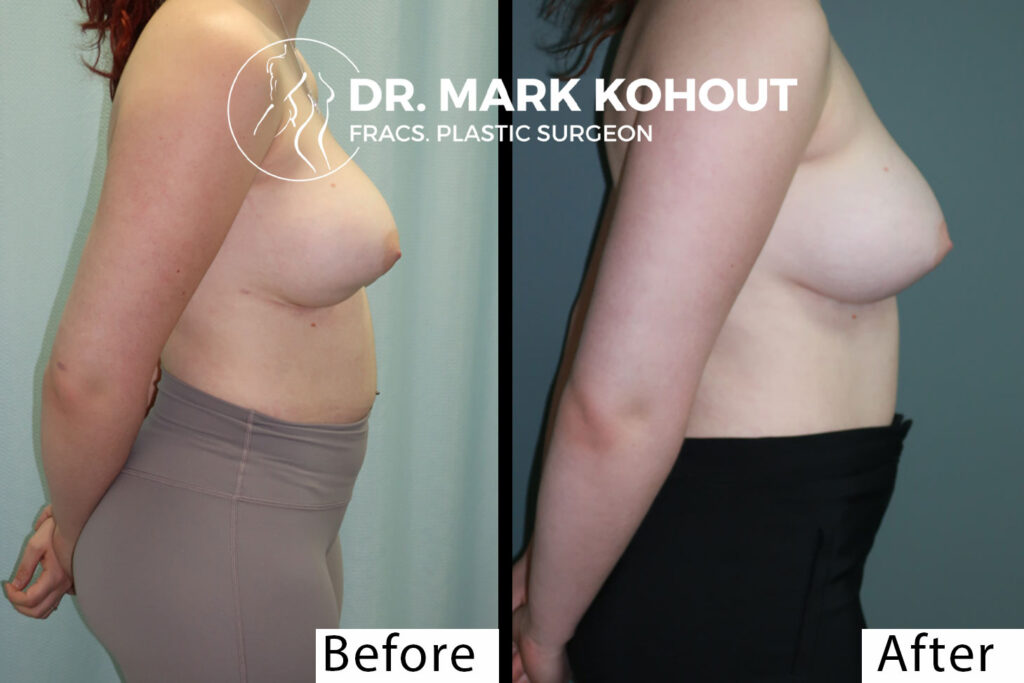
Breast augmentation has been performed for many decades, and it continues to be one of the most requested forms of cosmetic surgery worldwide. For most patients, the results remain satisfactory for a number of years. However, as time passes, natural ageing, changes in weight, or pregnancy can alter the relationship between the breast implant and the surrounding tissues. One of the recognised changes that can occur after augmentation is known as the waterfall deformity, a condition that some patients find concerning enough to seek corrective surgery.
This condition is characterised by a visible imbalance between the implant and the breast tissue. The implant remains in its intended position, but the natural breast tissue appears to descend or “slide” downward over it, producing a contour that many patients feel no longer matches their desired appearance.
Dr Mark Kohout, Specialist Plastic Surgeon based in Sydney, Australia, provides consultation and surgical management for patients who are considering breast revision surgery to address concerns such as the waterfall deformity. His approach is centred on providing patients with an informed understanding of the condition, outlining the surgical options available, and supporting expectations that are realistic and tailored to individual anatomy.
Understanding The Waterfall Deformity
✓ What Is Waterfall Deformity?
The waterfall deformity, sometimes referred to as “sliding ptosis,” is a descriptive term for a situation in which the natural breast tissue sits lower than the breast implant. In this condition, the implant maintains its original placement, often high on the chest, while the overlying breast tissue gradually descends due to changes in skin elasticity and structural support. This creates an uneven appearance, with the implant appearing unnaturally high and the breast tissue visibly lower, often extending beneath the level of the inframammary fold.
This contrast between the implant and the natural tissue leads to the typical “double contour” or “step-off” deformity that characterises the waterfall appearance. The condition does not necessarily cause physical discomfort, but many patients feel dissatisfied with the aesthetic outcome, especially when the breasts no longer resemble the results they experienced after their original augmentation.
✓ Why Does It Happen?
The causes of waterfall deformity are complex and usually involve a combination of factors. Over time, natural ageing results in the stretching and thinning of skin and connective tissue, reducing their ability to support the weight of the breast tissue and the implant. Pregnancy and breastfeeding are also significant contributors, as they can cause fluctuations in breast size and tissue quality, sometimes leading to stretching of the skin and ligaments. Weight changes, whether through gain or loss, can alter the volume and distribution of breast tissue, further affecting the relationship between the implant and the natural breast.
The characteristics of the implant itself can also play a role. Larger implants exert more weight on the surrounding tissues and may accelerate tissue descent. The plane of placement – whether the implant is positioned above or below the muscle – also influences how the breast tissue and implant interact over time. The end result is that, in some patients, the implant remains fixed in its original position while the breast tissue moves downward, creating the distinct appearance associated with the waterfall deformity.
Signs And Symptoms Patients May Notice
✓ Visual Appearance
Patients often become aware of waterfall deformity when they notice that their breasts no longer appear balanced or symmetrical. The implant may seem unnaturally high, while the breast tissue itself hangs lower, giving the impression that the implant and breast are separate rather than unified. The nipple may appear to point downward or sit lower on the breast mound, which accentuates the difference between implant and tissue position. This change often becomes visible when looking at the breasts from the side, where the tissue can be seen draping below the implant.
✓ Physical And Emotional Considerations
Although waterfall deformity does not usually result in pain or physical symptoms, the appearance can lead patients to feel that their breasts no longer match their expectations or the results they initially sought through augmentation. Some individuals find it difficult to dress as they would like, while others feel self-conscious about their breast appearance. It is important to note that emotional responses vary, and not every patient with a waterfall deformity will choose to undergo surgery. For those who do, the main motivation is typically a desire to restore a more balanced appearance between the implant and the natural breast.
The Role Of Breast Revision Surgery
- What Is Breast Revision?
Breast revision surgery is the general term for any operation performed to correct or improve the results of previous breast surgery. In cases of waterfall deformity, the purpose of revision is to bring the implant and breast tissue into better alignment, creating a more balanced and natural relationship between the two. This type of surgery is not standardised; instead, it is tailored to the unique needs of each patient. A careful evaluation of tissue quality, implant placement, and overall anatomy is necessary to determine which surgical techniques may be most appropriate.
- Surgical Techniques For Waterfall Deformity
There are several possible surgical approaches to correcting waterfall deformity, and often more than one is combined in a single operation. Implant exchange or adjustment is frequently considered, particularly when the size or type of the implant contributes to the imbalance. Sometimes, repositioning the implant plane can provide better harmony with the natural breast.
A breast lift, or mastopexy, may be performed to reposition and reshape the natural breast tissue so that it sits higher on the chest wall. This addresses the downward descent of the tissue that defines the waterfall appearance. For many patients, the most effective strategy is to combine implant revision with mastopexy, as this allows both the implant and breast tissue to be repositioned together.
In certain cases, pocket adjustment or capsulorrhaphy is performed. This involves modifying the internal pocket that holds the implant, ensuring that the implant sits in the most stable and anatomically suitable position. Each of these approaches requires careful planning, and patients are encouraged to discuss with their surgeon which combination of techniques may offer the best outcome for their situation.
Planning For Breast Revision In Sydney
✓ Consultation With A Specialist Plastic Surgeon
The process begins with a thorough consultation. During this appointment, Dr Mark Kohout, Plastic Surgeon in Sydney, conducts a comprehensive examination of the breast, assessing the position of the implant, the quality of the tissue, and the degree of ptosis. The consultation also involves a detailed discussion of medical history, prior surgeries, and the individual’s goals for revision.
✓ Individualised Treatment Planning
Every patient presents with a unique combination of anatomical features and surgical history. The plan for revision must take into account the severity of the tissue descent, the size and placement of the implant, and the quality of the skin and connective tissue. Patients are guided through the potential benefits and limitations of each surgical option, as well as the risks associated with revision procedures. The emphasis is on informed decision-making, with patients encouraged to consider their options carefully and to set realistic expectations regarding the outcome.
Risks And Considerations
✓ Surgical Risks
Like all surgical procedures, breast revision carries potential risks. These include bleeding, infection, and scarring, as well as the possibility of changes in nipple or breast sensation. Some patients may experience asymmetry or irregularities in breast shape, and in some cases further revision procedures may be required in the future.
✓ Long-Term Considerations
It is important for patients to understand that breast implants are not lifetime devices. Even after correction of waterfall deformity, future changes in tissue or implant condition may lead to the need for additional surgery. The long-term management of implants involves regular monitoring and awareness of potential complications such as capsular contracture or implant rupture.
✓ Regulatory Guidance
In Australia, the Therapeutic Goods Administration (TGA) regulates breast implants and provides patient information leaflets, safety updates, and monitoring guidelines. Patients considering implant-related procedures are encouraged to review TGA resources so they can make well-informed decisions.
Recovery After Breast Revision
✓ What Patients Can Expect
Recovery after breast revision varies according to the type of surgery performed and the individual’s healing process. In general, patients are advised to limit strenuous activities for several weeks, as this allows tissues to heal properly and reduces the risk of complications. Swelling and bruising are normal and gradually improve, and support garments are often recommended during the recovery period.
Most patients are able to return to light daily activities within a few weeks, but it is important to remember that healing is a gradual process and each patient’s experience is unique. Follow-up appointments are an essential part of recovery, ensuring that progress is monitored and that any concerns are addressed in a timely manner.
✓ Follow-Up Care
One of the key elements of revision surgery is continuity of care. Dr Mark Kohout in Sydney provides consultation, surgery, and follow-up personally, ensuring that patients are guided through every stage of their surgical journey. This ongoing care allows adjustments to be made if needed and helps support the best possible outcome for each patient.
Why Patients In Sydney Consider Breast Revision For Waterfall Deformity
✓ Local Relevance
Within Australia, there has been increasing attention on the long-term considerations associated with breast implants. Patients are more aware of the potential for changes over time, and many seek professional advice when issues such as waterfall deformity occur. In Sydney, patients have access to Specialist Plastic Surgeons who are familiar with local regulations and safety requirements, providing reassurance that their care is overseen by professionals with recognised qualifications.
✓ Patient Decision-Making Process
The decision to undergo revision surgery is highly personal. Some patients choose to live with the changes in their breast appearance, while others decide that surgery is the best way to address their concerns. During consultation, patients receive information about the risks and benefits of each surgical approach, as well as the limitations. This allows them to make a decision that is informed, balanced, and aligned with their personal goals.
Taking The Next Step
Waterfall deformity is a recognised development that can occur after breast augmentation, usually when the natural breast tissue descends relative to the implant. This condition may create a visible imbalance between the implant and the tissue, leading some patients to seek corrective surgery. Breast revision surgery offers a range of approaches that may improve the alignment between implant and tissue, from implant exchange to mastopexy or a combination of procedures.
Every surgical plan is developed according to the patient’s individual circumstances. While outcomes vary, patients can expect to receive a clear explanation of risks, recovery requirements, and the long-term considerations associated with implant surgery. Dr Mark Kohout, Specialist Plastic Surgeon in Sydney, provides consultation and surgical management for patients seeking advice on breast revision and related concerns.
FAQs About Correcting The Waterfall Deformity With Breast Revision Surgery
What makes the waterfall deformity different from other implant-related changes?
• The waterfall deformity occurs when natural breast tissue descends below the level of the implant, creating a visible step or imbalance. This is different from implant malposition, where the implant itself shifts, or capsular contracture, where the scar tissue around the implant tightens.
Can the waterfall deformity occur even if the implants were placed correctly at the start?
• Yes. The deformity is often due to natural changes in breast tissue over time rather than the initial surgical technique. Even when implants are correctly positioned, factors such as skin elasticity, ageing, weight changes, and pregnancy can still contribute.
Is the waterfall deformity more common with certain implant placements?
• It is more frequently observed in patients with implants placed under the muscle. In this position, the implant remains stable while the breast tissue above it may gradually descend, leading to the step-off appearance.
Does everyone with waterfall deformity require surgery?
• Not necessarily. Some patients choose not to pursue revision if the appearance does not cause significant concern. Others seek surgical correction when they feel the imbalance is noticeable or inconsistent with their personal goals.
What happens during consultation for waterfall deformity?
• Consultation involves a physical examination of breast tissue, implant placement, and the degree of ptosis. Medical and surgical history are reviewed, and options such as implant exchange, breast lift, or a combination are explained in detail so patients can make an informed choice.
How does breast revision surgery address both implant and tissue at the same time?
• In many cases, revision combines techniques. For example, an implant may be adjusted or exchanged while the breast tissue is lifted with mastopexy. Addressing both factors together helps align the implant and tissue in a way that suits the individual’s anatomy.
Are there long-term considerations after correcting waterfall deformity?
• Yes. Implants are not lifetime devices, and breast tissue continues to change with age, weight, and lifestyle. While revision may correct the imbalance, patients are advised that further changes can occur and ongoing monitoring is recommended.
Medical References
- The waterfall effect in breast augmentation – PMC https://pmc.ncbi.nlm.nih.gov/articles/PMC5409900/
- Revision Breast Augmentation – PMC https://pmc.ncbi.nlm.nih.gov/articles/PMC8186996/
- Recognizing and Managing Breast Implant Complications – Dove Press https://www.dovepress.com/article/download/102756
- Aesthetic breast surgery: putting in context—a narrative review – Annals of Translational Medicine https://gs.amegroups.org/article/view/76579/html
Next Steps with Dr Mark Kohout
If you are considering breast revision surgery in Sydney for issues such as the waterfall deformity, you may benefit from a consultation with Dr Mark Kohout, Specialist Plastic Surgeon. A consultation provides an opportunity for a thorough clinical examination and an informed discussion of surgical options tailored to your specific needs.
Further Reading
- Read Dr Mark Kohout’s Blog on Recovery After Breast Lift Surgery (Mastopexy)
- Read Dr Mark Kohout’s Blog on Breast Implants Revisions: Assessing the Need for Surgery
Related Blog Posts
Healing and Recovery After Breast Reduction…
Comprehensive Guide to Healing and Recovery After Breast Reduction Surgery Download Dr Mark Kohout’s Breast Reduction Surgery Guide Healing and Recovery After Breast Reduction: Timeline and Tips Breast reduction surgery,…
Breast Reduction Medicare Cover – Will…
Will Medicare Cover My Breast Reduction? Breast reduction, medically known as reduction mammoplasty, is a surgical procedure that removes excess breast tissue and skin to achieve a breast size more…
Reducing Back Pain with Breast Reduction…
The Connection between Back Pain and Overly Large Breasts For some women, overly large breasts can be a source of discomfort and pain, particularly in the back region. The weight of…
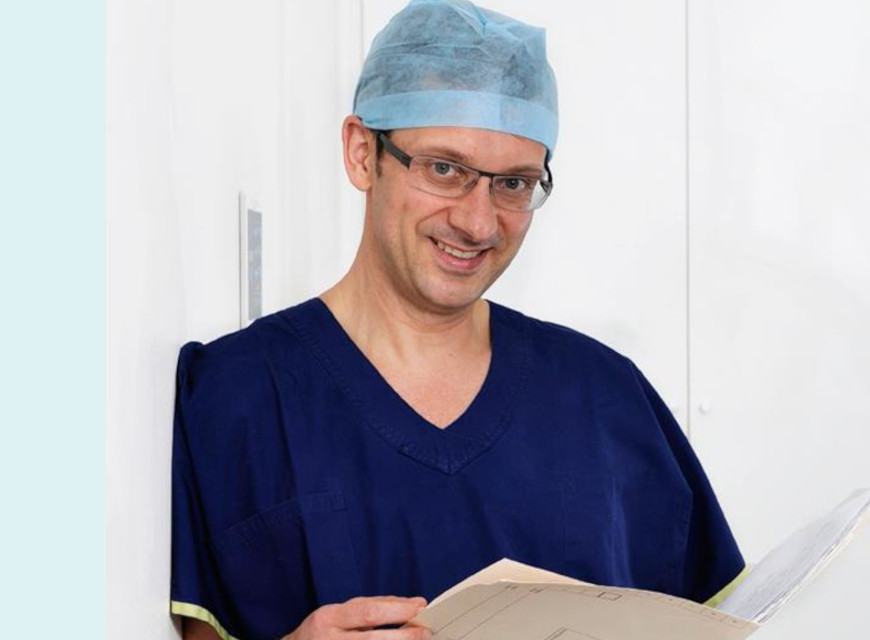
Experienced Plastic Surgeon
Dr. Mark Kohout
A qualified plastic surgeon who operates with care and integrity, based in central Sydney with over 20 years of experience in the cosmetic field. His extensive training and experience assures patients they are in highly trained surgical hands. Dr. Kohout is a dedicated, friendly professional who is committed to providing the high quality care, support and results, alongside his compassionate team.
Dr Mark Kohout (MED0001133000)
Specialist Plastic Surgeon
Specialist registration in Surgery – Plastic Surgery


